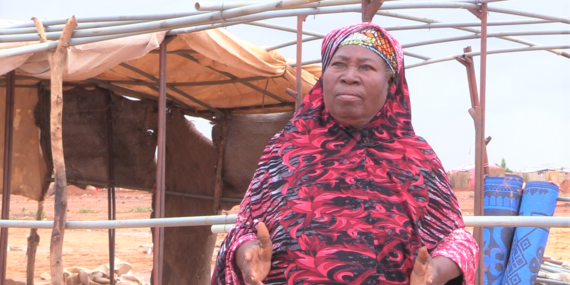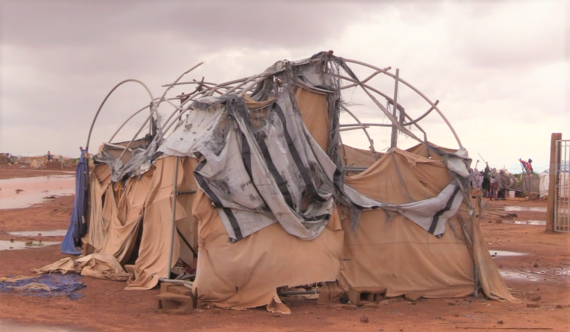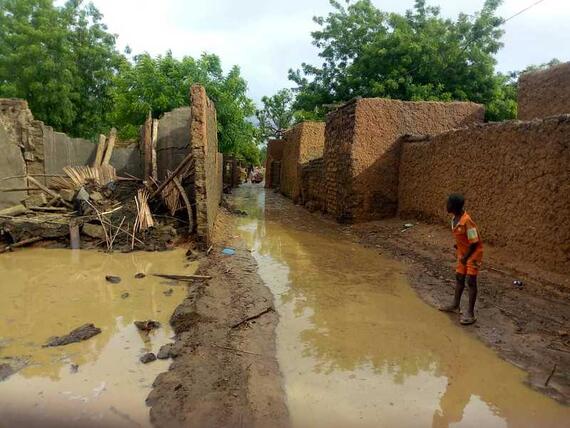Niger’s accelerating climate crisis

by Laura Fultang, OCHA Public Information Officer
“My grandson almost drowned due to heavy rainfall that flooded our hut,” said Habsou Oumarou, a tearful widow and mother of eight. “We were lucky enough to save him, but many others were not as fortunate.”
Habsou and her family are internally displaced persons (IDPs) at the newly established Cité des Enseignants Chercheurs camp in Niger’s capital, Niamey, which is flooded by heavy rains that began in early July.
The ongoing rains have claimed lives and wreaked havoc on houses and infrastructure. As of 25 September, floods had affected more than 248,000 people and killed at least 182 people, according to the Government.
Habsou was among the 12,000 people who the Government relocated last year, from the Gamou and Hippodrome IDP camps to their current camp. She and other IDPs are grateful for the piece of land they each received from the Government upon moving to the Enseignants Chercheurs camp, but their homes are often flooded by heavy rains. Habsou emphasizes the need for more resilient housing.
“There are many elderly persons among us, and we need help with the construction of more permanent houses,” she said.
Niger is one of the countries in West Africa hit hardest by the climate crisis. According to an author of the Intergovernmental Panel on Climate Change assessment report, temperatures in the Sahel are increasing 1.5 times faster than anywhere else in the world, and the number of floods almost doubled between 2015 and 2020. These effects are exacerbating Niger’s humanitarian situation. Last year, torrential rain and floods affected more than 250,000 people in all of Niger’s eight regions and killed 77 people.

Maradi is the worst-hit region, followed by Zinder. Persistent floods damaged more than 26,000 houses and destroyed about 1,720 hectares of farmland, depleting affected people’s livelihoods. Some roads are now impassable, hindering access to affected people in already hard-to-reach areas. Their priority needs include food, shelter and non-food items. Humanitarian organizations are responding, but needs are increasing as the rain continues to pour.
Dealing with disease
The persistent rains have already caused a cholera outbreak. On 5 September, the Government announced the country’s first cholera case. Maradi has the highest number of cases — 36 cases were registered in its Madarounfa health district as of 18 September, with no deaths.
“We are supporting the Government in its response to the cholera epidemic,” said the World Health Organization’s Dr. Didier Tambwe, who is also the Health Cluster Coordinator in Niger. “Our biggest challenge is to break the transmission chain and to contain it within the affected region. To this end, we are collaborating with communities on behavioural change while promoting good hygiene practices, such as washing hands with clean water and soap.”
Finding solutions
Eighty per cent of Niger’s population (25 million people) depend on agriculture for their livelihoods. It’s therefore no surprise that climate change, increased food insecurity, malnutrition and record-high food prices fuelled by the war in Ukraine are all contributing to Niger’s unprecedented humanitarian needs.

So far, heavy rains have destroyed more than 14,000 tons of food and killed some 686 livestock. Niger was already facing a severe food and nutrition crisis — about 4.4 million people (17 per cent of the population) are food insecure. And despite the efforts of the Government and its partners, Niger is among the 10 countries in the world most affected by severe acute malnutrition in children under age 5, according to the UN Children’s Fund.
In February, the Emergency Relief Coordinator, Martin Griffiths, allocated US$10 million from the UN Central Emergency Response Fund (CERF) to support more than 300,000 people affected by food insecurity in Niger.
But Niger’s crisis is complex, with overlapping security, humanitarian and development needs. Humanitarian response is not the long-term solution.
Dr. Modibo Traoré, OCHA’s Head of Office in Niger, explained: “It is now crucial for humanitarian, development and stabilization partners to work in tandem, based on do-no-harm principles and community acceptance, to provide life-saving and sustainable assistance to the most vulnerable people in Niger. There is a strong need to provide emergency responses while also ensuring medium- and long-term preventative and sustainable solutions.”
Dealing with drought
Almost every year, Nigeriens must also contend with cyclical droughts. This year, while people in the east were dealing with floods, people in the country’s south-east were experiencing drought brought on by the lowest rainfall in 30 years.
To prevent and mitigate the drought’s immediate impact, the Government and the UN launched an anticipatory action response in August, funded by a $9.5 million CERF allocation.
With these funds, OCHA and its partners will support the most vulnerable and at-risk communities through health, education, agriculture and nutrition interventions.
You Can Help
As the climate crisis accelerates, the most vulnerable people are bearing the brunt of its impact, particularly refugees and IDPs, like Habsou, who do not have the resources to adapt. Vulnerabilities are being amplified where people with weather-dependent livelihoods are already facing poverty, conflict, and limited access to basic services and resources.
The number of people in Niger who need help has increased by 65 per cent, from 2.3 million people in 2019 to 3.7 million people in 2022.
The UN Humanitarian Response Plan is seeking $553.6 million to provide multisectoral support to 2.3 million people, including over half a million displaced people.
Your donation will help the UN and humanitarian partners to rapidly provide life-saving assistance to the people in Niger who need it the most.
